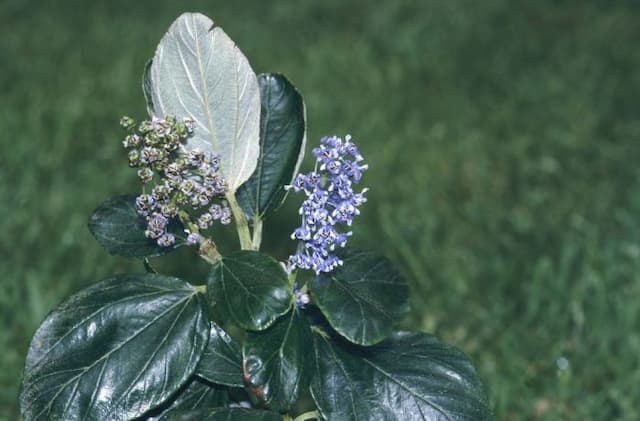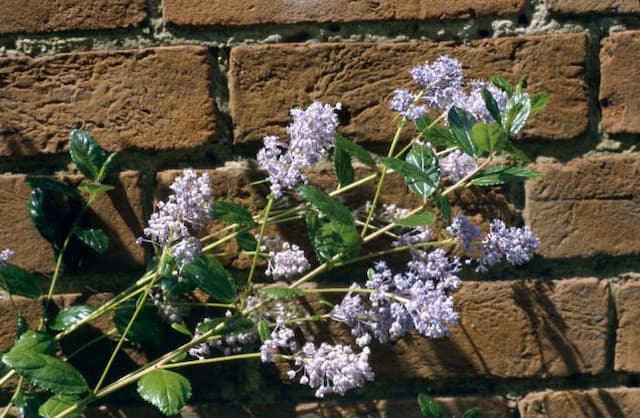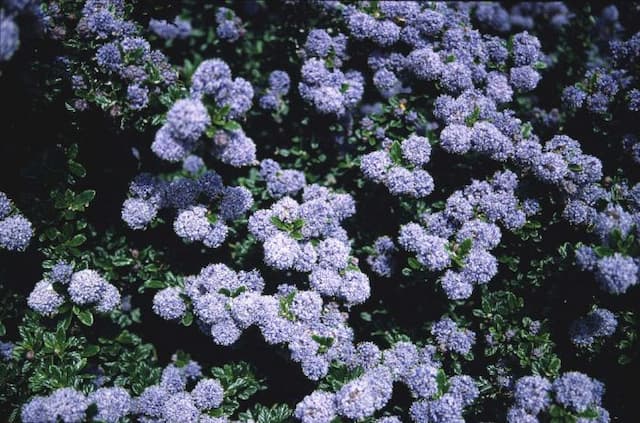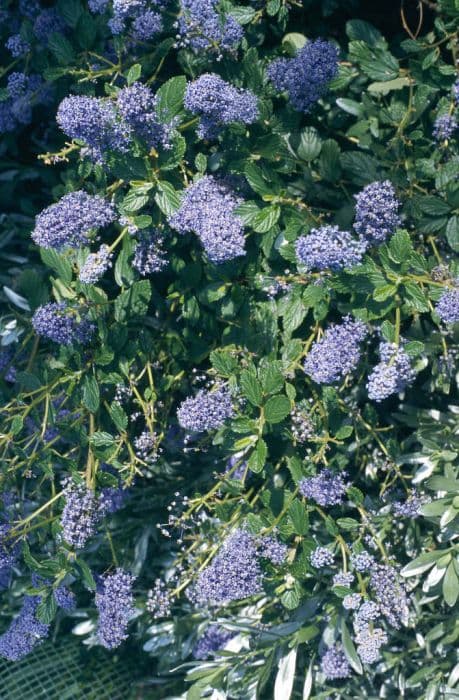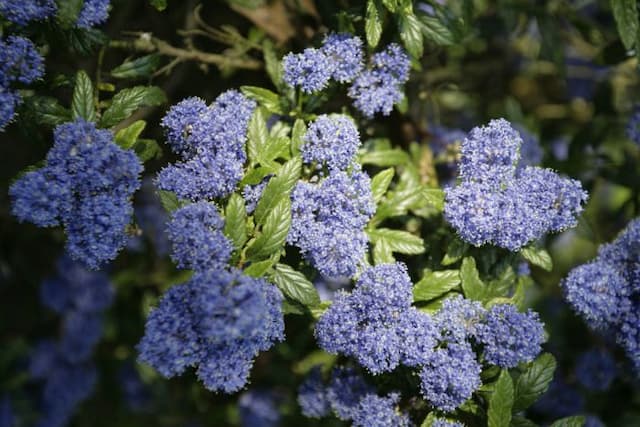California Lilac Ceanothus 'Cascade'
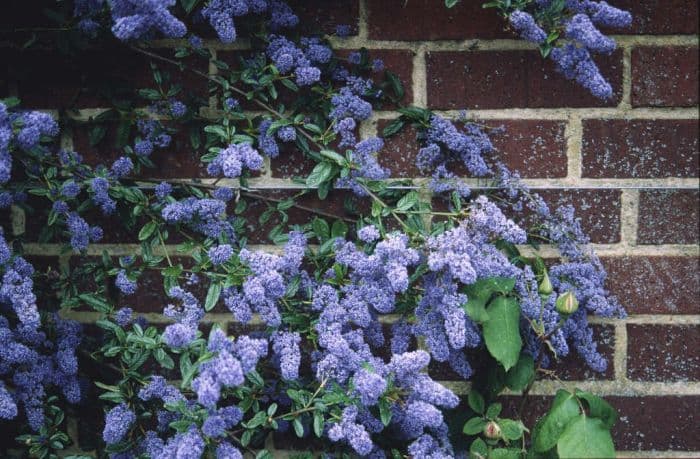
ABOUT
Ceanothus 'Cascade' is commonly known as the California lilac. It is a visually striking plant with a bushy, rounded growth habit. The leaves of the California lilac are small, oval to rounded, and exhibit a lush green hue that emanates a dense, leathery texture. Often, the foliage remains evergreen, providing a constant vibrancy throughout the year. The most captivating feature of the California lilac is its abundant clusters of flowers. These blossoms are typically a deep shade of blue, although they can sometimes vary and present in lighter blue or even purplish tones. The panicles of flowers are tightly packed and form cone-shaped clusters that cover the shrub profusely, creating a dramatic burst of color that can be quite eye-catching. These blooms are also noted for their delightful fragrance, which can attract various pollinators, including bees and butterflies. The overall appearance of Ceanothus 'Cascade' is one of robust vitality, with a fine balance between its rich, green foliage and the striking blue of its floral display. It remains a popular choice for gardeners looking to add a splash of long-lasting color to their landscape.
About this plant
 Names
NamesFamily
Rhamnaceae
Synonyms
California Lilac, Mountain Lilac, Blueblossom, Wild Lilac
Common names
Ceanothus 'Cascade'
 Toxicity
ToxicityTo humans
The Ceanothus 'Cascade', commonly known as the California lilac, is not widely known to be toxic to humans. There are no specific reports of poisoning related to California lilac. In general, it is always advisable to avoid ingesting plants that are not specifically meant for consumption, as individual allergic reactions or other adverse effects can occur.
To pets
California lilac is not commonly listed as a toxic plant for pets, which includes both dogs and cats. There is limited information on any symptoms of poisoning from this plant, as it does not appear to be a common cause of pet poisoning. However, it is still best to prevent pets from eating ornamental plants as they could potentially lead to gastrointestinal upset or allergic reactions in some animals.
 Characteristics
CharacteristicsLife cycle
Perennials
Foliage type
Evergreen
Color of leaves
Green
Flower color
Blue
Height
6-8 feet (1.8-2.4 meters)
Spread
6-8 feet (1.8-2.4 meters)
Plant type
Shrub
Hardiness zones
7
Native area
North America
Benefits
 General Benefits
General Benefits- Attracts Pollinators: Ceanothus 'Cascade' is known to attract bees, butterflies, and other beneficial insects, promoting biodiversity.
- Drought Tolerance: Once established, it requires minimal water, making it suitable for xeriscaping and dry climate gardens.
- Low Maintenance: Ceanothus 'Cascade' typically needs little pruning or care once it's established.
- Fast Growing: This plant can quickly fill in garden spaces, providing a lush appearance in a relatively short period of time.
- Erosion Control: The extensive root system can help stabilize slopes and prevent soil erosion.
- Evergreen Foliage: It retains its leaves throughout the year, providing continuous greenery and structure in the garden.
- Landscape Versatility: Suitable for use as a hedge, screen, or as part of a mixed border.
- Native Habitat Support: Being a native species, it offers habitat support for local wildlife and preserves the regional ecological balance.
- Decorative Blooms: Produces clusters of blue or purple flowers which add color and fragrance to garden spaces.
- Year-Round Interest: In addition to its evergreen foliage and spring flowers, some specimens can produce attractive seed pods in the fall.
 Medical Properties
Medical PropertiesThis plant is not used for medical purposes.
 Air-purifying Qualities
Air-purifying QualitiesThis plant is not specifically known for air purifying qualities.
 Other Uses
Other Uses- Ceanothus 'Cascade' can be used as a natural dye when the flowers or leaves are processed properly, imparting shades of green or brown depending on the mordant used.
- The dense habit of California lilac makes it an effective privacy screen when planted in a row or as a hedge in gardens and landscapes.
- Its resilience to drought conditions allows California lilac to be used in xeriscaping, which is landscaping designed to minimize water usage.
- The wood of the California lilac is robust and has been traditionally used to make small wooden objects like handles and stakes.
- California lilac can be used in slope stabilization and erosion control due to its rooting system that helps to hold the soil in place.
- Incorporating California lilac into a wildlife garden can support native pollinators, as it is a source of nectar for bees and butterflies.
- Its strikingly blue flowers can be used in floral arrangements as cut flowers, adding a pop of color to bouquets.
- The plant's dense foliage can offer a shaded microclimate for other shade-loving plants when grown in close proximity.
- California lilac can act as a windbreak when planted in strategic locations, helping to protect smaller, more delicate plants from strong winds.
- The fallen leaves and spent blooms contribute to creating a rich leaf mold under the plant, which can be used as mulch for enhancing soil quality.
Interesting Facts
 Feng Shui
Feng ShuiThe California Lilac is not used in Feng Shui practice.
 Zodiac Sign Compitability
Zodiac Sign CompitabilityThe California Lilac is not used in astrology practice.
 Plant Symbolism
Plant Symbolism- Renewal: The Ceanothus 'Cascade', commonly known as California Lilac, blooms profusely in the spring, symbolizing new beginnings and the renewal of nature.
- Hope: Its vibrant blue flowers are often associated with hope and optimism, representing the anticipation of good things to come.
- Resilience: As a plant that thrives in challenging conditions with minimal water, it embodies resilience and the ability to persevere through hardships.
- Hospitality: With its lush foliage and appealing scent, the California Lilac is seen as a symbol of hospitality and welcoming environments.
- Patriotism: Native to California, this plant can signify local pride or patriotism for those who live in or have an affinity with the state or the American West.
 Water
WaterCalifornia Lilac, also known as Ceanothus 'Cascade', does best with deep and infrequent watering. Aim to give the plant a good soak, providing about 1 to 1.5 inches of water, which translates to approximately 0.62 to 0.94 gallons for a small shrub, every two to three weeks during the dry season. Once established, California Lilac is quite drought-tolerant and may only require watering every three to four weeks. During the winter, if there is sufficient rainfall, additional watering might not be necessary. Always check the soil moisture before watering; the top few inches should be dry to the touch.
 Light
LightCalifornia Lilac thrives best in full sun conditions, meaning it should receive at least six hours of direct sunlight daily to perform optimally. It is important to place California Lilac in a location where it is exposed to unfiltered sunlight for the majority of the day. However, note that in extremely hot climates, some afternoon shade may be beneficial to prevent scorching.
 Temperature
TemperatureThe California Lilac is hardy and can survive in temperatures as low as 10 to 15 degrees Fahrenheit, and its ideal growing range is between 55 and 75 degrees Fahrenheit. It can tolerate high temperatures well, but excessive heat may stress the plant if not accompanied by appropriate watering. Ensure that California Lilac is planted in a location where it can avoid the risk of frost, which can damage the foliage and blooms.
 Pruning
PruningPrune the California Lilac to maintain its shape and to remove any dead or damaged branches. The best time to prune is immediately after the blooming period, typically in late spring or early summer, as the plant sets its flower buds for the following year soon after. Pruning too late in the season can result in a loss of next year's blooms. Regular pruning is also necessary to encourage air circulation within the plant, which helps prevent disease.
 Cleaning
CleaningAs needed
 Soil
SoilThe California Lilac, Ceanothus 'Cascade', thrives in well-draining soil with a pH range of 5.5 to 7.5. A suitable soil mix can be created by combining equal parts of loam, coarse sand, and peat or a peat substitute for acidity. Additionally, integrating organic compost will enrich the soil, improving plant health and bloom.
 Repotting
RepottingThe California Lilac, Ceanothus 'Cascade', does not require frequent repotting and can typically be repotted every 2-3 years as it prefers not to be disturbed. Ensure that the new pot is only slightly larger than the previous one as this shrub likes to be somewhat root-bound.
 Humidity & Misting
Humidity & MistingThe California Lilac, Ceanothus 'Cascade', is adaptable to a range of humidity conditions typical of outdoor environments and does not have specific humidity requirements; it fares well in the natural humidity of its growing area.
 Suitable locations
Suitable locationsIndoor
Place in bright light, avoid overwatering, no special indoor humidity needed.
Outdoor
Plant in full sun, well-draining soil, water moderately.
Hardiness zone
7-10 USDA
 Life cycle
Life cycleThe life cycle of the Ceanothus 'Cascade', commonly known as the California Lilac, begins with germination, where the seeds require heat from fire or scarification to break dormancy. Once germinated, seedlings establish a root system and grow rapidly, entering the juvenile phase with the production of foliage and immature woody stems. As the plant matures, it enters the flowering stage, typically in late winter to early spring, showcasing clusters of blue to purple flowers that attract pollinators. After pollination, the plant sets seed in the form of small, hard capsules which are then dispersed, often requiring another fire event or mechanical disturbance to open and release seeds. Throughout its life, the California Lilac may undergo cycles of growth, flowering, and seeding for several years, with individual plants living up to about 25 years or occasionally longer in ideal conditions. In the final stage of its life, the plant senesces, with declining vigor and productivity until it ultimately dies, completing the lifecycle.
 Propogation
PropogationPropogation time
Spring to Summer
The California Lilac 'Cascade', typically propagated by semi-hardwood cuttings, reveals its readiness for propagation during the late summer months. The most popular method involves taking a 4 to 6-inch (approximately 10 to 15 centimeters) cutting from a healthy, semi-hardwood section of the plant—this is a part of the stem that has matured partially but is not fully hardened. Once cut, the lower leaves should be removed, and the cut end dipped in rooting hormone to encourage root growth. The cutting is then placed in a well-draining soil mix, ensuring that the soil is kept moist but not waterlogged. To maintain a humid environment around the cutting, it is often beneficial to cover the container with a plastic bag or place it in a propagator. With appropriate warmth and light, roots should begin to develop within several weeks, after which the new California Lilac 'Cascade' plant can be gradually acclimated to less protected conditions before being transplanted outdoors.
